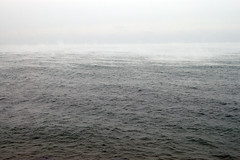Here’s a story of danger at sea from a federal agency officer who wants to be “on the low.”
I’ll tell you what he told me about his most dangerous workplace moment – without revealing his name nor that of his agency. The most dangerous thing he ever did at work was going out to sea in a Zodiac and boarding a huge ship. He did this as required – on rare occasions – as part of his duties as a federal public service manager.
“Some officers have better training – those more frequently on the water.” he said. “I might have felt like saying no – but frankly – I was thrilled to do it.”
I asked if he’d been trained to board ships at sea, but he said no. He had lots of training – firearms training, combat defence, and vessel inspection – but nothing specific to boarding ships at sea. He wore a life jacket and hung on tight.
“You can imagine it’s a very, very tall ship and to do that at sea, they typically slow down to about 6 knots in a rigid hull inflatable boat – a Zodiac – and they come along side of it,” he said, describing how he got from the Zodiac onto the ship. “They match the speeds and then they get close as they can get to it – usually within a metre or less. Then you go up a Jacob’s ladder – those cargo ladders you used in school, climbing up two or three storeys.”
The dangers of cold water
One major risk he faced was the cold water. If a wave hit him or he lost his grip, he could have fallen into the super-cold ocean and been vulnerable to cold water shock – which happens much more quickly than drowning.
“Cold shock occurs immediately — as you enter the cold water,” reads a WorkSafeBC bulletin, Cold Water Immersion.
“It lasts three to five minutes but it can result in quick drowning because of the way the body reacts. You cannot control these reactions:
• A large intake of breath
• A rapid increase in breathing rate (up to four times as fast)
• A reduced ability to hold your breath (to as little as 10 seconds)
• A massive increase in heart rate and blood pressure.”
Thankfully this officer got on board the ship without incident – and now he has a quite a story to tell. Do you? Email susan@speakingofsafety.ca.



